 In this blog we show how we can apply fiscal metrics to assess the UK government’s fiscal stance. This captures the extent to which fiscal policy contributes to the level of economic activity in the economy.
In this blog we show how we can apply fiscal metrics to assess the UK government’s fiscal stance. This captures the extent to which fiscal policy contributes to the level of economic activity in the economy.
Changes in the fiscal stance can then be used to estimate the extent to which discretionary fiscal policy measures represent a tightening or loosening of policy. We can measure the size and direction of fiscal impulses arising from changes in the government’s budgetary position.
Such an analysis is timely given the Autumn Budget presented by Rachel Reeves on 30 October 2024. This was the first Labour budget in 14 years and the first ever to be presented by a female Chancellor of the Exchequer.
We conclude by considering the forecast profile of expenditures and revenues for the next few years and the new fiscal rules announced by the Chancellor.
The fiscal stance
At its most simple, the fiscal stance measures the extent to which fiscal policy increases or decreases demand, thereby influencing growth and inflation (see Box 1.F, page 28, Autumn Budget 2024: see link below).
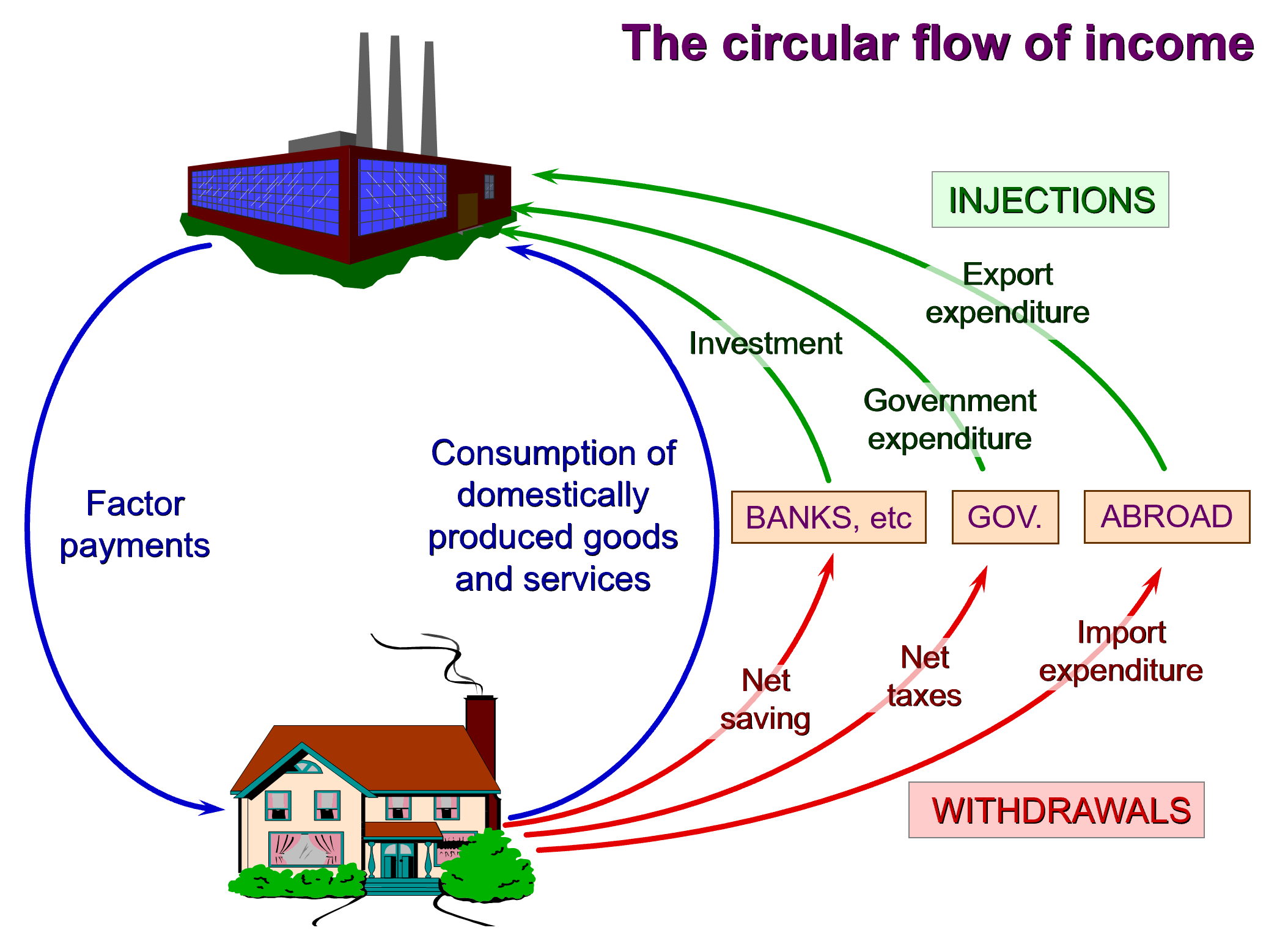 The fiscal stance is commonly estimated by measures of pubic-sector borrowing. To understand this, we can refer to the circular flow of income model. In this model, excesses of government spending (an injection) over taxation receipts (a withdrawal or leakage) represent a net injection into the circular flow and hence positively affect the level of aggregate demand for national output, all other things being equal.
The fiscal stance is commonly estimated by measures of pubic-sector borrowing. To understand this, we can refer to the circular flow of income model. In this model, excesses of government spending (an injection) over taxation receipts (a withdrawal or leakage) represent a net injection into the circular flow and hence positively affect the level of aggregate demand for national output, all other things being equal.
A commonly used measure of borrowing in assessing the fiscal stance of the is the primary deficit. Unlike public-sector net borrowing, which is simply the excess of the sector’s spending over its receipts (largely taxation), the primary deficit subtracts net interest costs. It therefore excludes the interest payments on outstanding public-sector debts (and interest income earned on financial assets). The primary deficit can therefore be written as public-sector borrowing less net interest payments.
As discussed in our blog Fiscal impulses in November 2023, the primary deficit captures whether the public sector is able to afford its present fiscal choices by abstracting from debt-serving costs that reflect past fiscal choices. In this way, the primary deficit is a preferable measure to net borrowing both in assessing the impact on economic activity, i.e. the fiscal stance, and in assessing whether today’s fiscal choices will require government to issue additional debt.
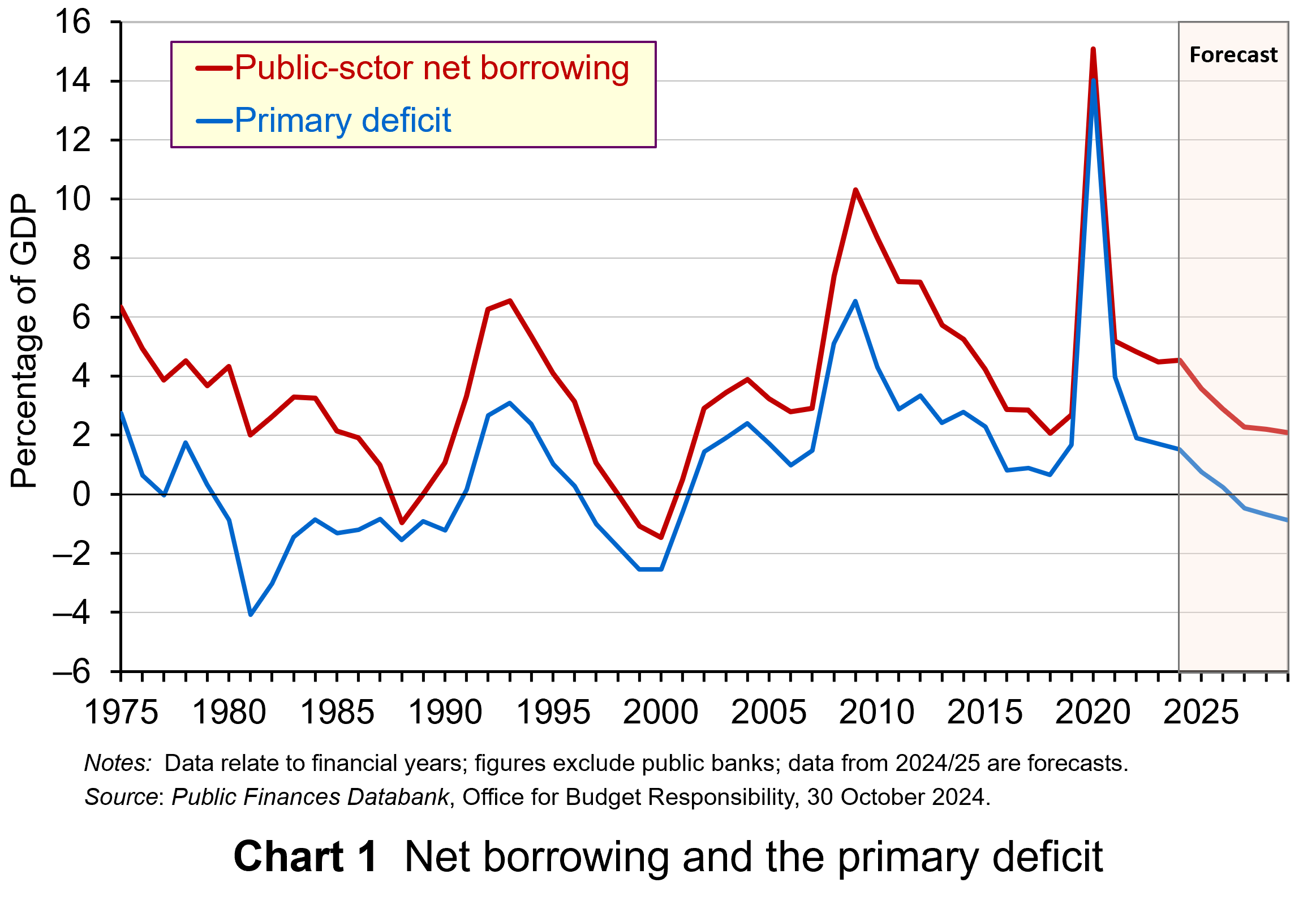 Chart 1 shows public-sector net borrowing and the primary balance as shares of GDP for the UK since financial year 1975/76 (click here for a PowerPoint). The data are from the latest Public Finances Databank published by the Office for Budget Responsibility, published on the day of the Autumn Budget in October (see Data links below).
Chart 1 shows public-sector net borrowing and the primary balance as shares of GDP for the UK since financial year 1975/76 (click here for a PowerPoint). The data are from the latest Public Finances Databank published by the Office for Budget Responsibility, published on the day of the Autumn Budget in October (see Data links below).
Over the period 1975/6 to 2023/24, public-sector net borrowing and the primary deficit had averaged 3.8% and 1.3% of GDP respectively. In the financial year 2023/24, they were 4.5% and 1.5% (they had been as high as 15.1% and 14.1% in 2020/21 as a result of COVID support measures). In 2024/25 net borrowing and the primary deficit are forecast to be 4.5% and 1.6% respectively. By 2027/28, while net borrowing is forecast to be 2.3% of GDP, there is forecast to be a primary surplus of 0.7% of GDP.
The Autumn Budget lays out plans for higher tax revenues to contribute two-thirds of the overall reduction in the primary deficit over the forecast period (up to 2029/30), while spending decisions contribute the remaining third.
The largest tax-raising measure is an increase in the employer rate of National Insurance Contributions (NICs) by 1.2 percentage points to 15% from April 2025. This will be levied on employee wages above a Secondary Threshold of £5000, reduced from £9100, which will increase in line with CPI inflation each year from April 2028. (See John’s blog, Raising the minimum wage: its effects on poverty and employment, for an analysis on the effects of this change.) This measure, allowing for other changes to the operation of employer NICs, is expected to raise £122 billion over the forecast period. This amounts to over two-thirds of the additional tax take from the taxation measures taken in the Budget.
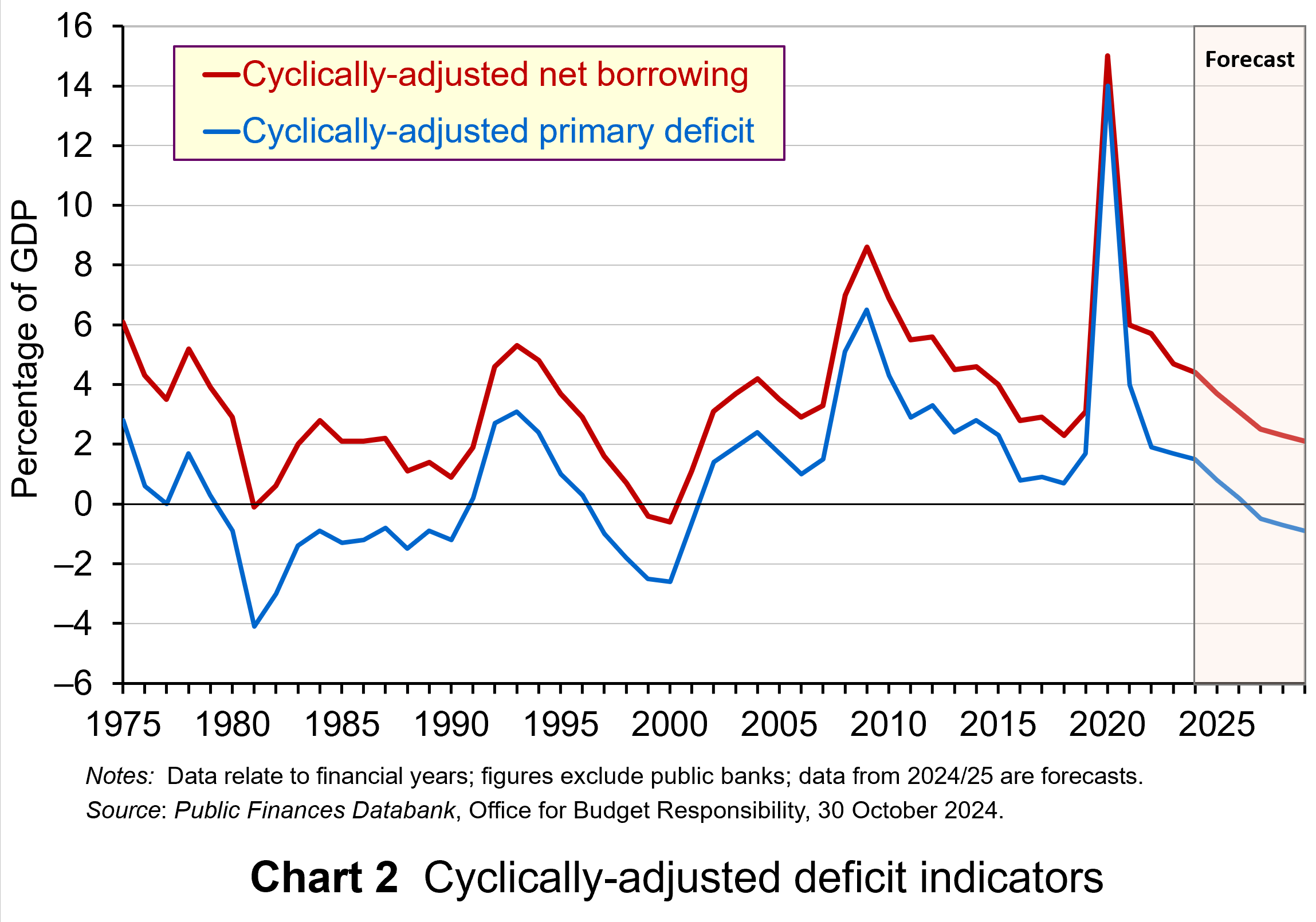 Chart 2 shows both net borrowing and the primary deficit after being cyclically-adjusted (click here for a PowerPoint). This process adjusts these fiscal indicators to account for those parts of spending and taxation that are affected by the position of the economy in the business cycle. These are those parts that act as automatic stabilisers helping, as the name suggests, to stabilise the economy.
Chart 2 shows both net borrowing and the primary deficit after being cyclically-adjusted (click here for a PowerPoint). This process adjusts these fiscal indicators to account for those parts of spending and taxation that are affected by the position of the economy in the business cycle. These are those parts that act as automatic stabilisers helping, as the name suggests, to stabilise the economy.
The process of cyclical adjustment leads to estimates of receipts and expenditures as if the economy were operating at its potential output level and hence with no output gap. The act of cyclically adjusting the primary deficit, which is our preferred measure of the fiscal stance, allows us to assess better the public sector’s fiscal stance.
Over the period from 1975/6 up to and including 2023/24, the cyclically-adjusted primary deficit (CAPD) averaged 1.1% of GDP. In 2024/25 the CAPD is forecast to be 1.5% of GDP. It then moves to a surplus of 0.5% by 2027/28. It therefore mirrors the path of the unadjusted primary deficit.
Measuring the fiscal impulse
To assess even more clearly the extent to which the fiscal stance is changing, we can use the cyclically-adjusted primary deficit to measure a fiscal impulse. This captures the magnitude of change in discretionary fiscal policy.
The term should not be confused with fiscal multipliers which measure the impact of fiscal changes on outcomes, such as real GDP and employment. Instead, we are interested in the size of the impulse that the economy is being subject to. Specifically, we are measuring discretionary fiscal policy changes that result in structural changes in the government budget and which, therefore, allow an assessment of how much, if at all, a country’s fiscal stance has tightened or loosened.
The size of the fiscal impulse is measured by the year-on-year percentage point change in the cyclically-adjusted public-sector primary deficit (CAPD) as a percentage of GDP. A larger deficit or a smaller surplus indicates a fiscal loosening. This is consistent with a positive fiscal impulse. On the other hand, a smaller deficit or a larger surplus indicates a fiscal tightening. This is consistent with a negative fiscal impulse.
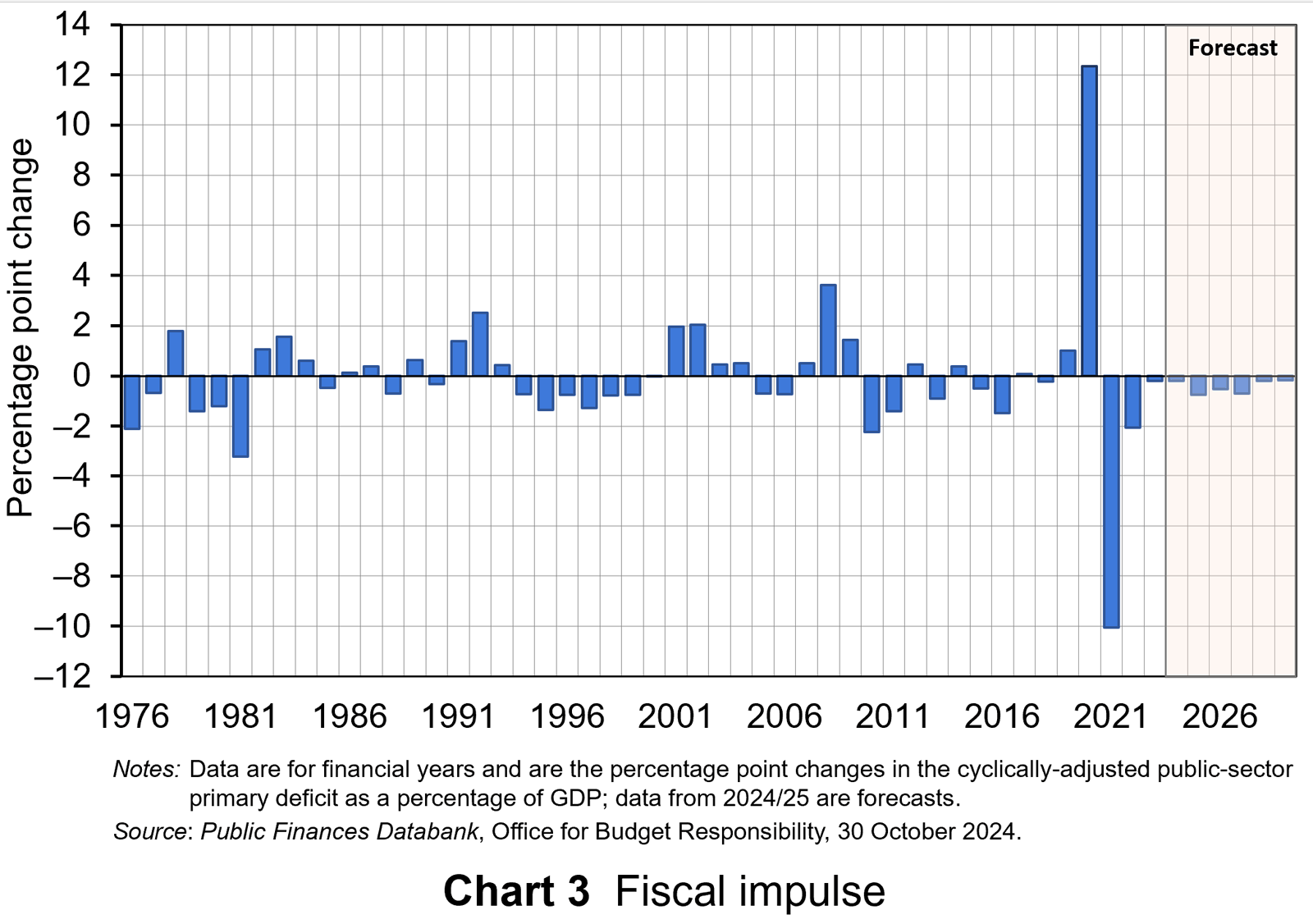 Chart 3 shows the magnitude of UK fiscal impulses since the mid-1970s (Click here for a PowerPoint file). The scale of the fiscal interventions in response to the COVID-19 pandemic, which included the COVID-19 Business Interruption Loan Scheme (CBILS) and Job Retention Scheme (‘furlough’), stand out sharply. In 2020 the CAPD to output ratio rose from 1.7 to 14.4%. This represents a positive fiscal impulse of 12.4% of GDP.
Chart 3 shows the magnitude of UK fiscal impulses since the mid-1970s (Click here for a PowerPoint file). The scale of the fiscal interventions in response to the COVID-19 pandemic, which included the COVID-19 Business Interruption Loan Scheme (CBILS) and Job Retention Scheme (‘furlough’), stand out sharply. In 2020 the CAPD to output ratio rose from 1.7 to 14.4%. This represents a positive fiscal impulse of 12.4% of GDP.
This was followed in 2021 by a tightening of the fiscal stance, with a negative fiscal impulse of 10.1% of GDP as the CAPD to output fell back to 4.0%. Subsequent tightening was tempered by policy measures to limit the impact on the private sector of the cost-of-living crisis, including the Energy Price Guarantee and Energy Bills Support Scheme.
For comparison, the fiscal response to the global financial crisis from 2007 to 2009 saw a cumulative positive fiscal impulse of 5.6% of GDP. While smaller in comparison to the discretionary fiscal responses to the COVID-19 pandemic, it nonetheless represented a sizeable loosening of the fiscal stance.
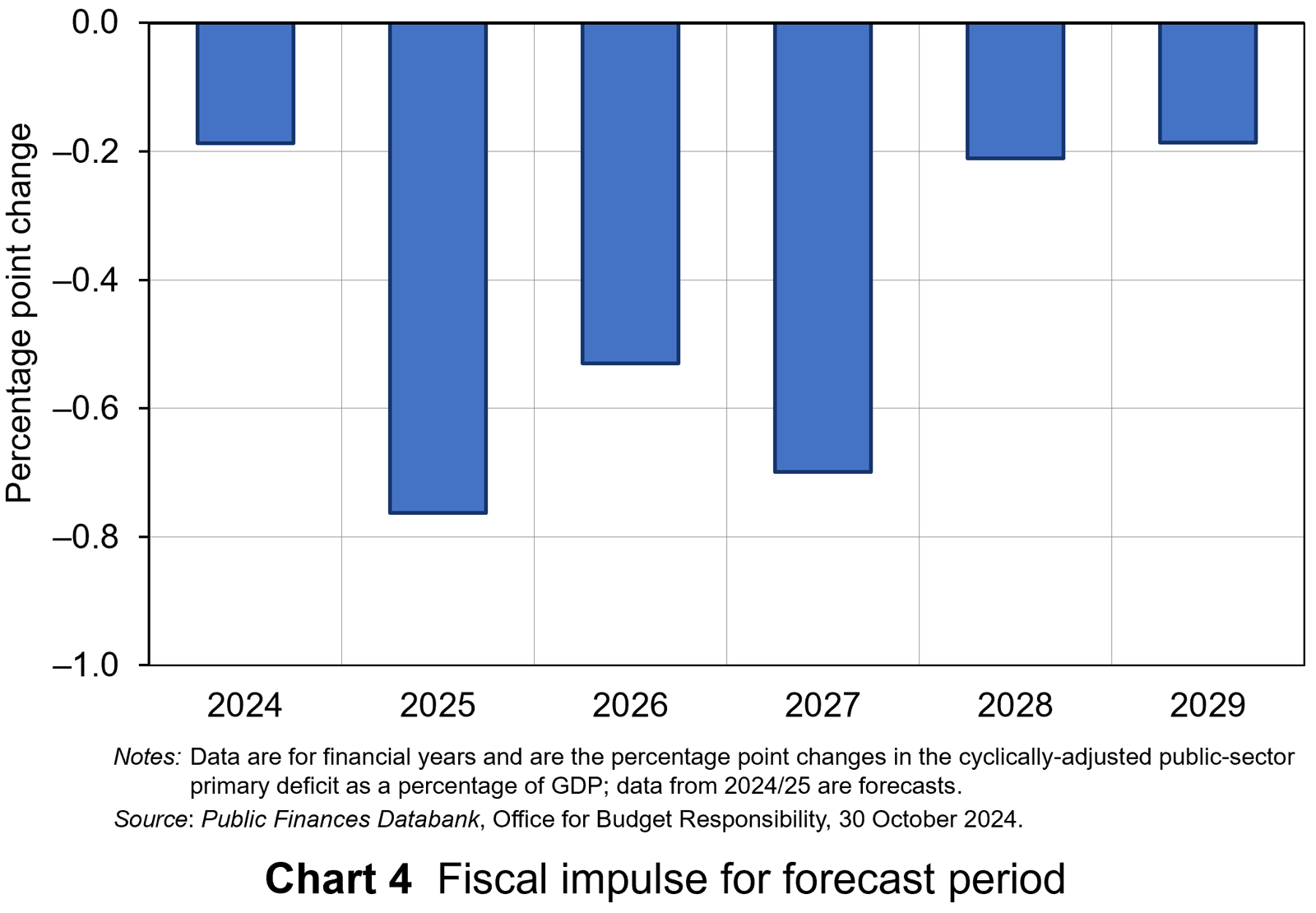 Chart 4 focuses on the implied fiscal impulse for the forecast period up to 2029/30 (click here for a PowerPoint). The period is notable for a negative fiscal impulse each year. Across the period as a whole, this there is a cumulative negative fiscal impulse of 2.6% of GDP. Most of the ‘heavy-lifting’ of the fiscal consolidation occurs in the three financial years from 2025/26 during which there is a cumulative negative impulse of 2.0% of GDP.
Chart 4 focuses on the implied fiscal impulse for the forecast period up to 2029/30 (click here for a PowerPoint). The period is notable for a negative fiscal impulse each year. Across the period as a whole, this there is a cumulative negative fiscal impulse of 2.6% of GDP. Most of the ‘heavy-lifting’ of the fiscal consolidation occurs in the three financial years from 2025/26 during which there is a cumulative negative impulse of 2.0% of GDP.
Looking forward
To conclude, we consider the implications for the projected profiles of public-sector spending, receipts and liabilities over the forecast period up to 2029/30.
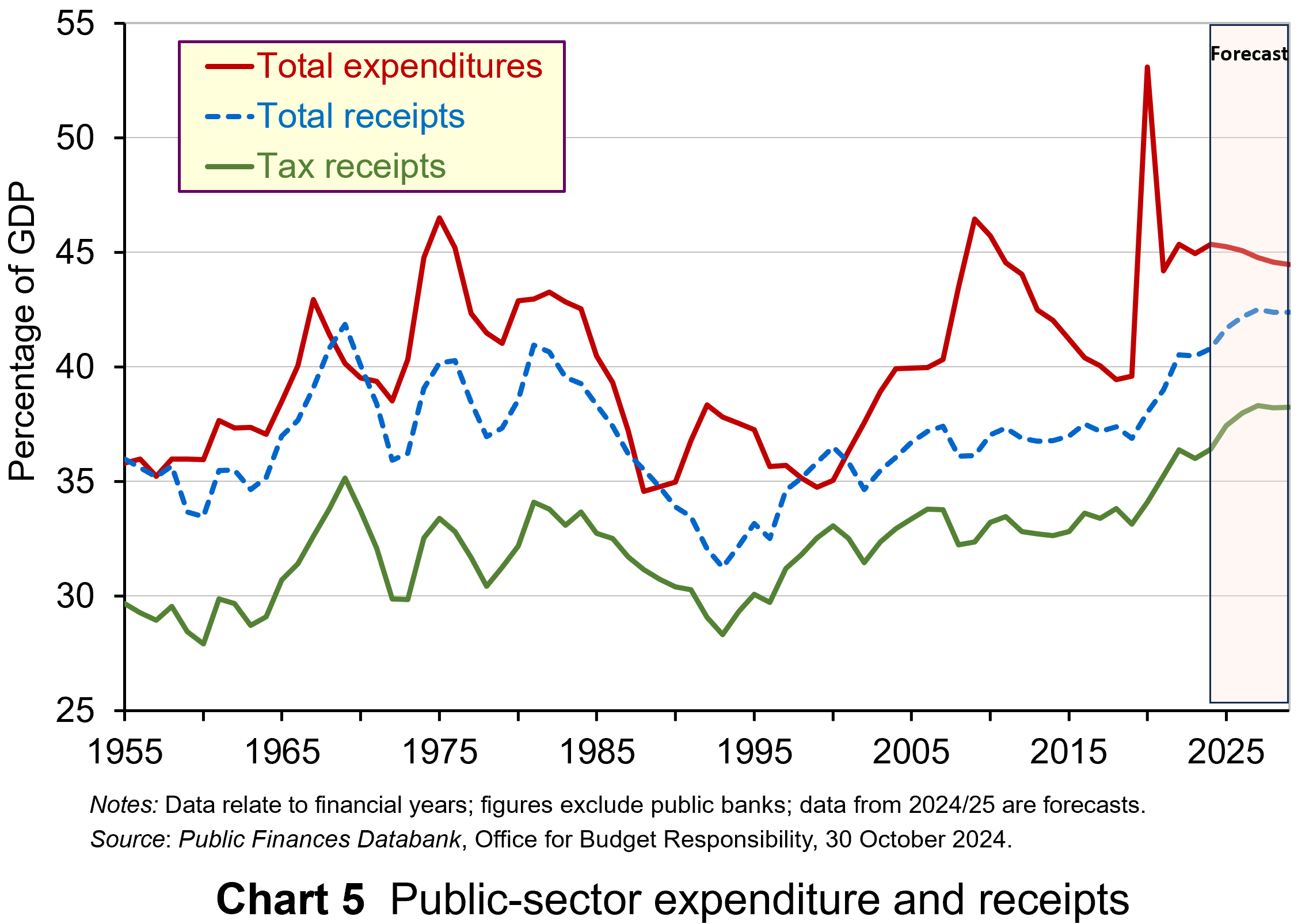 Chart 5 plots data since the mid-1950s (click here for a PowerPoint). It shows the size of total public-sector spending (also known as ‘total managed expenditures’), taxation receipts (sometimes referred as the ‘tax burden’) and total public-sector receipts as shares of GDP. This last one includes additional receipts, such as interest payments on financial assets and income generated by public corporations, as well as taxation receipts.
Chart 5 plots data since the mid-1950s (click here for a PowerPoint). It shows the size of total public-sector spending (also known as ‘total managed expenditures’), taxation receipts (sometimes referred as the ‘tax burden’) and total public-sector receipts as shares of GDP. This last one includes additional receipts, such as interest payments on financial assets and income generated by public corporations, as well as taxation receipts.
The OBR forecasts that in real terms (i.e. after adjustment for inflation), public-sector spending will increase on average over the period from 2025/26 to 2029/30 by 1.4% per year, but with total receipts due to rise more quickly at 2.5% per year and taxation receipts by 2.8% per year. The implications of this, as discussed in the OBR’s October 1014 Economic and Fiscal Outlook (see link below), are that:
the size of the state is forecast to settle at 44% of GDP by the end of the decade, almost 5 percentage points higher than before the pandemic” while additional tax revenues will “push the tax take to a historic high of 38% of GDP by 2029-30
Finally, the government has committed to two key rules: a stability rule and an investment rule.
The stability rule. This states that the current budget must be in surplus by 2029/30 or, once 2029/30 becomes the third year of the forecast period, it will be in balance or surplus every third year of the rolling forecast period thereafter. The current budget refers to the difference between receipts and expenditures other than capital expenditures. In effect, it captures the ability of government to meet day-to-day spending and is intended to ensure that over the medium term any borrowing is solely for investment. It is important to note that ‘balance’ is defined in a range of between a deficit and surplus of no more than 0.5% of GDP.
The stability rule replaces the borrowing rule of the previous government that public net borrowing, therefore inclusive of investment expenditures, was not to exceed 3% of GDP by the fifth year of the rolling forecast period.
 The investment rule. The government is planning to increase investment. In order to do this in a financially sustainable way, the investment rule states that public-sector net financial liabilities (PSNFL) or net financial debt for short, is falling as a share GDP by 2029/30, until 2029/30 becomes the third year of the forecast period. PSNFL should then fall by the third year of the rolling forecast period. PSNFL is a broader measure of the sector’s balance sheet than public-sector net debt (PSND), which was targeted under the previous government and which was required to fall by the fifth year of the rolling forecast period.
The investment rule. The government is planning to increase investment. In order to do this in a financially sustainable way, the investment rule states that public-sector net financial liabilities (PSNFL) or net financial debt for short, is falling as a share GDP by 2029/30, until 2029/30 becomes the third year of the forecast period. PSNFL should then fall by the third year of the rolling forecast period. PSNFL is a broader measure of the sector’s balance sheet than public-sector net debt (PSND), which was targeted under the previous government and which was required to fall by the fifth year of the rolling forecast period.
The new target, as well as now extending to the Bank of England, ‘nets off’ not just liquid assets (i.e. cash in the bank and foreign exchange reserves) but also financial assets such as shares and money owed to it, including expected student loan repayments. While liabilities are broader too, including for example, the local government pension scheme, the impact is expected to reduce the new liabilities target by £236 billion or 8.2 percentage points of GDP in 2024/25. The hope is that both rules can support what the Budget Report labels a ‘step change in investment’.
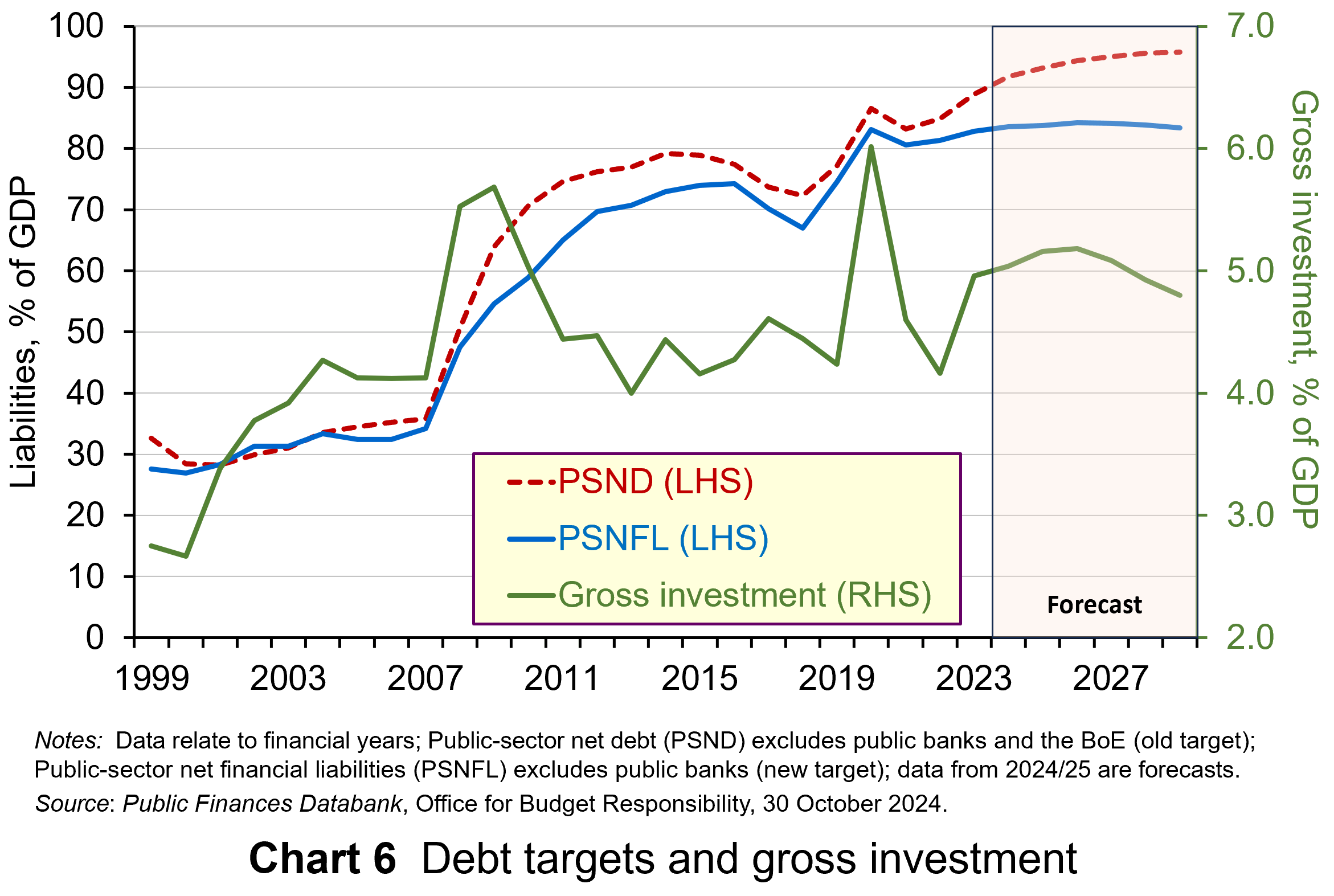 As Chart 6 shows, public investment as a share of GDP has not exceeded 6% this century and during the 2010s averaged only 4.4% (click here for a PowerPoint). The forecast has it rising above 5% for a time, but easing to 4.8% by end of the period.
As Chart 6 shows, public investment as a share of GDP has not exceeded 6% this century and during the 2010s averaged only 4.4% (click here for a PowerPoint). The forecast has it rising above 5% for a time, but easing to 4.8% by end of the period.
This suggests more progress will be needed if the UK is to experience a significant and enduring increase in public investment. Of course, this needs to be set in the context of the wider public finances and is illustrative of the choices facing fiscal policymakers across the globe after the often violent shocks that have rocked economies and impacted on the state of the public finances in recent years.
Articles
Official documents
Data
Questions
- Explain what is meant by the following fiscal terms:
(a) Structural deficit,
(b) Automatic stabilisers,
(c) Discretionary fiscal policy,
(d) Public-sector net borrowing,
(e) Primary deficit,
(f) Current budget balance,
(g) Public-sector net financial liabilities (PSNFL).
- Explain the difference between a fiscal impulse and a fiscal multiplier.
- In designing fiscal rules what issues might policymakers need to consider?
- What are key differences between the fiscal rules of the previous Conservative government and the new Labour government in the UK? What economic arguments would you make for and against the ‘old’ and ‘new’ fiscal rules?
- What is meant by the ‘sustainability’ of the public finances? What factors might impact on their sustainability?
 The following blog is inspired by my teaching of macroeconomic issues to my final year students at Aston University. In the classes we’ve been discussing important aspects of monetary and fiscal policy design. What has become clear to me and my students is that the trade-offs which characterise the discipline of economics are certainly alive and well in the current environment in which monetary and fiscal policy choices are being made.
The following blog is inspired by my teaching of macroeconomic issues to my final year students at Aston University. In the classes we’ve been discussing important aspects of monetary and fiscal policy design. What has become clear to me and my students is that the trade-offs which characterise the discipline of economics are certainly alive and well in the current environment in which monetary and fiscal policy choices are being made.
To demonstrate this we consider here some of the discussions we’ve had in class around central bank independence and monetary policy mandates. We’ve also looked at fiscal policy. Here we’ve examined the state of the public finances and the importance that seems to be attached to debt stabilisation and the imposition of debt rules.
Delegation and central bank mandates
My teaching this term began by introducing my students to one of the most important and influential monetary policy models. This is the model of Kydland and Prescott. Their model, published in the Journal of Political Economy in 1977 has become the theoretical bedrock for the modern-day operational independence of central banks.1
 The model explores how systemically high inflation can become established in economies when policymakers have the political incentive to lower unemployment or increase output above its long-run equilibrium value. This may be the case if governments operate monetary policy rather than the central bank (of if the central bank operates monetary policy but follows government objectives). By adopting expansionary monetary policy, governments can increase their popularity.
The model explores how systemically high inflation can become established in economies when policymakers have the political incentive to lower unemployment or increase output above its long-run equilibrium value. This may be the case if governments operate monetary policy rather than the central bank (of if the central bank operates monetary policy but follows government objectives). By adopting expansionary monetary policy, governments can increase their popularity.
But this is likely to be short-lived, as any increased economic activity will only be temporary (assuming that the natural-rate hypothesis holds). Soon, inflation will rise.
But, if an election is on the horizon, there may be enough time to boost output and employment before inflation rises. In other words, an expectations-augmented Phillips curve may present governments with an incentive to loosen monetary policy and worry about the inflation consequences after the election.
However, the resulting ‘inflation surprise’ through the loosening of monetary policy means a fall in real pay and therefore in purchasing power. If people suspect that governments will be tempted to loosen policy, they will keep their expectations of inflation higher than the socially optimal inflation rate. Consequently, low-inflation targets lack credibility when governments have the temptation to loosen monetary policy. Such targets are time-inconsistent because governments have an incentive to renege and deliver higher inflation through a looser monetary policy. The result is an inflation bias.
Central bank independence
To prevent this inflationary bias arising, many central banks around the world have been given some form of operational independence with a mandate centred around an inflation-rate target. By delegating monetary policy to a more conservative central bank, the problem of inflationary bias can be addressed.
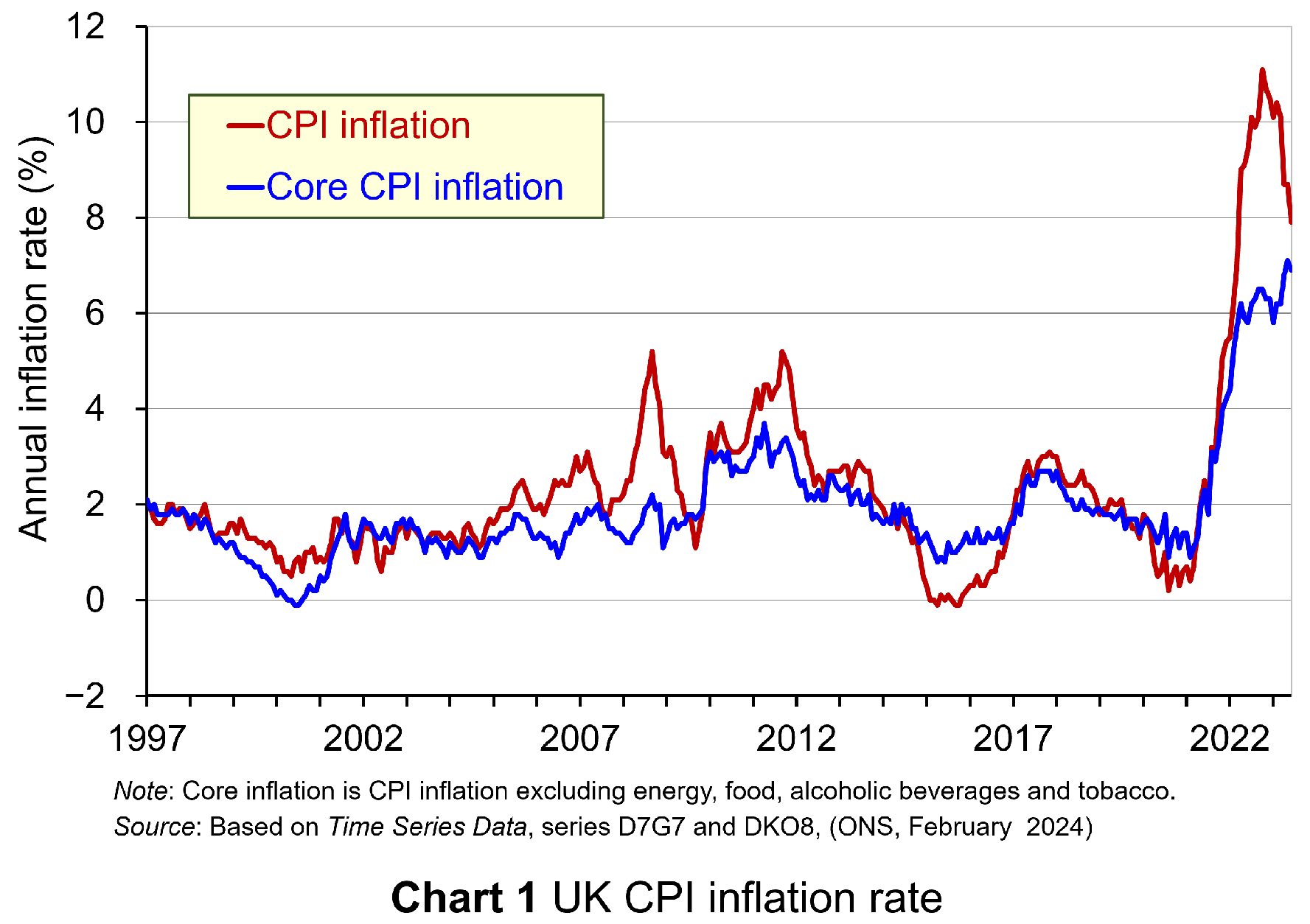 Yet central bank independence is not without its own issues and this has been an important part of the discussions with my students. Today, many economies are continuing to experience the effects of the inflationary shocks that began in 2021 (see Chart 1 for the UK CPI inflation rate: click here for a PowerPoint). The question is whether the appointment of a conservative or hard-nosed hawkish central banker trades off the stabilisation of inflation for greater volatility in output or unemployment.
Yet central bank independence is not without its own issues and this has been an important part of the discussions with my students. Today, many economies are continuing to experience the effects of the inflationary shocks that began in 2021 (see Chart 1 for the UK CPI inflation rate: click here for a PowerPoint). The question is whether the appointment of a conservative or hard-nosed hawkish central banker trades off the stabilisation of inflation for greater volatility in output or unemployment.
The inflation–output stabilisation trade-off is closely associated with the works of Kenneth Rogoff2 and John Taylor3. The latter is known for his monetary policy rule, which has become known as the ‘Taylor rule’. This advocates that a rules-based central bank ought to place weight on both inflation and output stabilisation.
This is not without its own issues, however, since, by also placing weight on output stabilisation, we are again introducing the possibility of greater inflationary bias in policy making. Hence, while the act of delegation and a rules- or target-based approach may mitigate the extent of the bias relative to that in the Kydland and Prescott model, there nonetheless still remain issues around the design of the optimal framework for the conduct of monetary policy.
Indeed, the announcement that the UK had moved into recession in the last two quarters of 2023 can be seen as evidence that an otherwise abstract theoretical trade-off between inflation and output stabilisation is actually very real.
My classroom discussions have also shown how economic theory struggles to identify an optimal inflation-rate target. Beyond accepting that a low and stable inflation rate is desirable, it is difficult to address fully the student who asks what is so special about a 2% inflation target. Would not a 3% target, for example, be preferable, they might ask?
Whilst this may sound somewhat trivial, it has real-world consequences. In a world that now seems to be characterised by greater supply-side volatility and by more frequent inflation shocks than we were used to in recent history, might a higher inflation rate target be preferable? Certainly, one could argue that, with an inflation–output stabilisation trade-off, there is the possibility that monetary policy could be unduly restrictive in our potential new macroeconomic reality. Hence, we might come to see governments and central banks in the near future revisiting the mandates that frame the operation of their monetary policy. Time will tell.
Fiscal policy and debt stabilisation
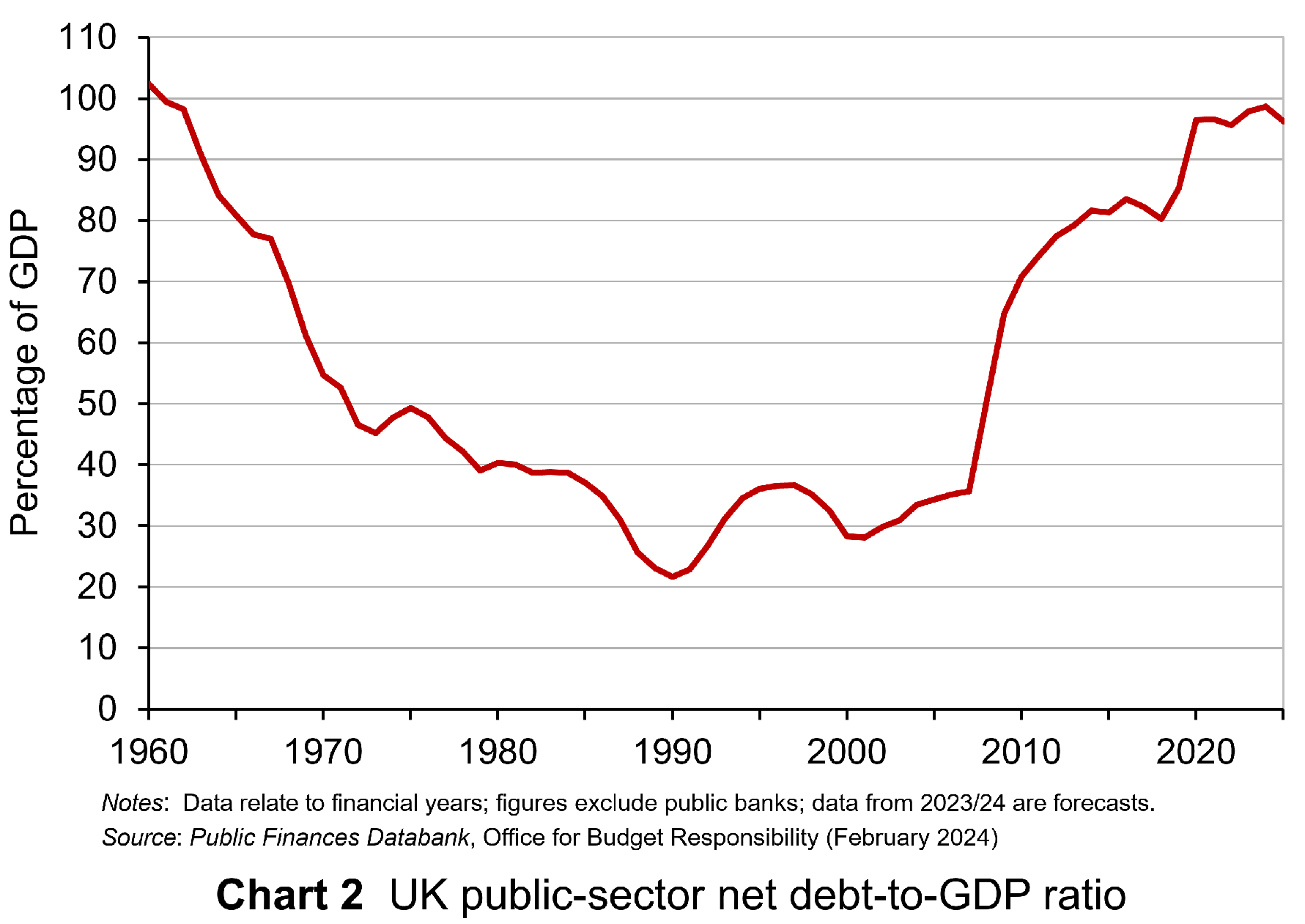 The second topic area that I have been discussing in my final-year macroeconomics classes has centred around fiscal policy and the state of the public finances. The context for this is that we have seen a significant increase in public debt-to-GDP ratios over the past couple of decades as the public sector has attempted to absorb significant economic shocks. These include the global financial crisis of 2007–8, the COVID-19 pandemic and the cost-of-living crisis. These interventions in the case of the UK have seen its public debt-to-GDP ratio more than triple since the early 2000s to close to 100% (see Chart 2: click here for a PowerPoint).
The second topic area that I have been discussing in my final-year macroeconomics classes has centred around fiscal policy and the state of the public finances. The context for this is that we have seen a significant increase in public debt-to-GDP ratios over the past couple of decades as the public sector has attempted to absorb significant economic shocks. These include the global financial crisis of 2007–8, the COVID-19 pandemic and the cost-of-living crisis. These interventions in the case of the UK have seen its public debt-to-GDP ratio more than triple since the early 2000s to close to 100% (see Chart 2: click here for a PowerPoint).
Understandably, given the stresses placed on the public finances, economists have increasingly debated issues around debt sustainability. These debates have been mirrored by politicians and policymakers. A key question is whether to have a public debt rule. The UK has in recent years adopted such a rule. The arguments for a rule centre on ensuring sound public finances and maintaining the confidence of investors to purchases public debt. A debt rule therefore places a discipline on fiscal policy, with implications for taxation and spending.
How easy it is to stick to a debt rule depends on three key factors. It will be harder to stick to the rule:
- The higher the current debt-to-GDP ratio and hence the more it needs to be reduced to meet the rule.
- The higher the rate of interest and hence the greater the cost of servicing the public debt.
- The lower the rate of economic growth and hence the less quickly will tax revenues rise.
With a given debt-to-GDP ratio, a given average interest rate payable on its debt, and a given rate of economic growth, we can determine the primary fiscal balance relative to GDP a government would need to meet for the debt-to-GDP ratio to remain stable. This is known as the ‘debt-stabilising primary balance’. The primary balance is the difference between a government’s receipts and its expenditures less the interest payments on its debt.
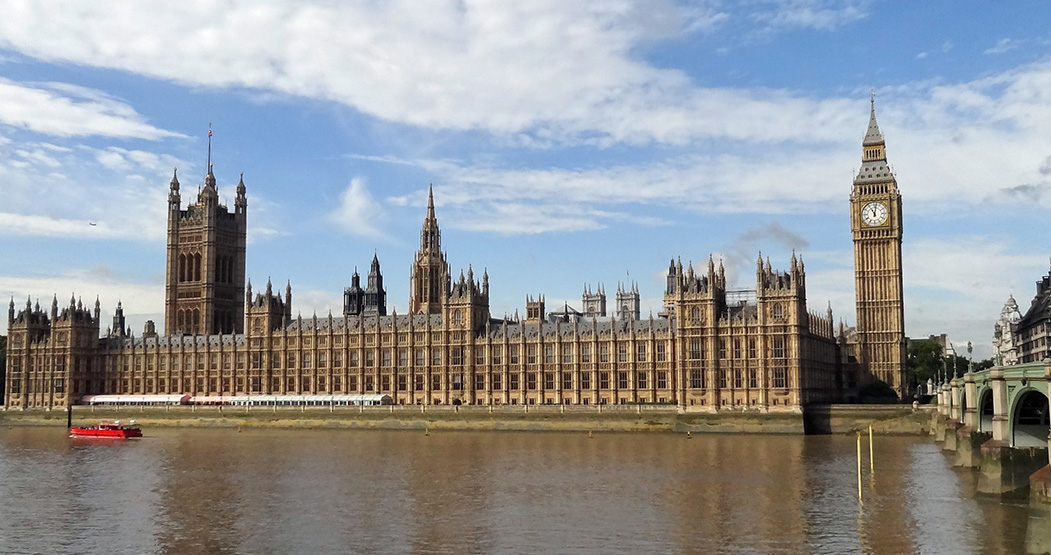 This fiscal arithmetic is important in determining a government’s fiscal choices. It shows the implications for spending and taxation. These implications become ever more important and impactful on people, businesses, and society when the fiscal arithmetic becomes less favourable. This is a situation that appears to be increasingly the case for many countries, including the UK, as the rate of interest on public debt rises relative to a country’s rate of economic growth. As this happens, governments are increasingly required to run healthier primary balances. This of course implies a tightening of their fiscal stance.
This fiscal arithmetic is important in determining a government’s fiscal choices. It shows the implications for spending and taxation. These implications become ever more important and impactful on people, businesses, and society when the fiscal arithmetic becomes less favourable. This is a situation that appears to be increasingly the case for many countries, including the UK, as the rate of interest on public debt rises relative to a country’s rate of economic growth. As this happens, governments are increasingly required to run healthier primary balances. This of course implies a tightening of their fiscal stance.
Hence, the fiscal conversations with my students have focused on both the benefits and the costs of debt-stabilisation. In respect of the costs, a few issues have arisen.
First, as with the inflation-rate target, it is hard to identify an optimal public debt-to-GDP ratio number. While the fiscal arithmetic may offer some clue, it is not straightforward to address the question as to whether a debt-to-GDP ratio of say 100% or 120% would be excessive for the UK.
Second, it is possible that the debt stabilisation itself can make the fiscal arithmetic of debt stabilisation more difficult. This occurs if fiscal consolidation itself hinders long-term economic growth, which then makes the fiscal arithmetic more difficult. This again points to the difficulties in designing policy frameworks, whether they be for monetary or fiscal policy.
Third, a focus on debt stabilisation alone ignores the fact that there are two sides to any sector’s balance sheet. It would be very unusual when assessing the well-being of businesses or households if we were to ignore the asset side of their balance sheet. Yet, this is precisely the danger of focusing on public debt at the exclusion of what fiscal choices can mean for public-sector assets, from which we all can potentially benefit. Hence, some would suggest a more balanced approach to assessing the soundness of the public finances might involve a net worth (assets less liabilities) measure. This has parallels with the debates around whether mandates of central banks should be broader.
Applications in macroeconomics
What my teaching of a topics-based macroeconomics module this term has vividly demonstrated is that concepts, theories, and models come alive, and are capable of being understood better, when they are used to shine a light on real-world issues. The light being shone on monetary and fiscal policy in today’s turbulent macroeconomic environment is perhaps understandably very bright.
Indeed, the light being shone on fiscal policy in the UK and some other countries facing an upcoming election, is intensified further with the state of the public finances shaping much of the public discourse on fiscal choices. Hopefully, my students will continue to debate these important issues beyond their graduation, stressing their importance for people’s lives and, in doing so, going beyond the abstract.
References
- Rules rather than discretion: The inconsistency of optimal plans
The Journal of Political Economy, Finn E Kydland and Edward C. Prescott (1977, 85(3), pp 473–92)
- The optimal degree of commitment to an intermediate monetary target
Quarterly Journal of Economics, Kenneth Rogoff (November 1985, 100(4), pp 1169–89)
- Discretion versus policy rules in practice
Carnegie-Rochester Conference Series on Public Policy, John B Taylor (December 1993, 39, pp 195–214)
Articles
Questions
- What is meant by time-inconsistent monetary policy announcements? How has this concept been important for the way in which many central banks now conduct monetary policy?
- What is meant by a ‘conservative’ central banker? Why is the appointment of this type of central banker thought to be important in affecting inflation?
- What is the contemporary macroeconomic relevance of the inflation–output (or inflation–unemployment) stabilisation trade-off?
- How is the primary balance different from the actual budget balance?
- What do you understand by the concept of ‘the fiscal arithmetic’. Explain how each element of the fiscal arithmetic affects the debt-stabilising primary balance?
- Analyse the costs of benefits of a debt-based fiscal rule.
 With many countries experiencing low growth some 12 years after the financial crisis and with new worries about the effects of the coronavirus on output in China and other countries, some are turning to a Keynesian fiscal stimulus (see Case Study 16.6 on the student website). This may be in the form of tax cuts, or increased government expenditure or a combination of the two. The stimulus would be financed by increased government borrowing (or a reduced surplus).
With many countries experiencing low growth some 12 years after the financial crisis and with new worries about the effects of the coronavirus on output in China and other countries, some are turning to a Keynesian fiscal stimulus (see Case Study 16.6 on the student website). This may be in the form of tax cuts, or increased government expenditure or a combination of the two. The stimulus would be financed by increased government borrowing (or a reduced surplus).
The hope is that there will also be a longer-term supply-side effect which will boost potential national income. This could be through tax reductions creating incentives to invest or work more efficiently; or it could be through increased capacity from infrastructure spending, whether on transport, energy, telecommunications, health or education.
In the UK, the former Chancellor, Sajid Javid, had adopted a fiscal rule similar to the Golden Rule adopted by the Labour government from 1997 to 2008. This stated that, over the course of the business cycle, the government should borrow only to invest and not to fund current expenditure. Javid’s rule was that the government would balance its current budget by the middle of this Parliament (i.e. in 2 to 3 years) but that it could borrow to invest, provided that this did not exceed 3% of GDP. Previously this limit had been set at 2% of GDP by the former Chancellor, Philip Hammond. Using his new rule, it was expected that Sajid Javid would increase infrastructure spending by some £20 billion per year. This would still be well below the extra promised by the Labour Party if they had won the election and below what many believe Boris Johnson Would like.
 Sajid Javid resigned at the time of the recent Cabinet reshuffle, citing the reason that he would have been required to sack all his advisors and use the advisors from the Prime Minister’s office. His successor, the former Chief Secretary to the Treasury, Rishi Sunak, is expected to adopt a looser fiscal rule in his Budget on March 11. This would result in bigger infrastructure spending and possibly some significant tax cuts, such as a large increase in the threshold for the 40% income tax rate.
Sajid Javid resigned at the time of the recent Cabinet reshuffle, citing the reason that he would have been required to sack all his advisors and use the advisors from the Prime Minister’s office. His successor, the former Chief Secretary to the Treasury, Rishi Sunak, is expected to adopt a looser fiscal rule in his Budget on March 11. This would result in bigger infrastructure spending and possibly some significant tax cuts, such as a large increase in the threshold for the 40% income tax rate.
A Keynesian stimulus would almost certainly increase the short-term economic growth rate as inflation is low. However, unemployment is also low, meaning that there is little slack in the labour market, and also the output gap is estimated to be positive (albeit only around 0.2%), meaning that national income is already slightly above the potential level.
 Whether a fiscal stimulus can increase long-term growth depends on whether it can increase capacity. The government hopes that infrastructure expenditure will do just that. However, there is a long time lag between committing the expenditure and the extra capacity coming on stream. For example, planning for HS2 began in 2009. Phase 1 from London to Birmingham is currently expected to be operation not until 2033 and Phase 2, to Leeds and Manchester, not until 2040, assuming no further delays.
Whether a fiscal stimulus can increase long-term growth depends on whether it can increase capacity. The government hopes that infrastructure expenditure will do just that. However, there is a long time lag between committing the expenditure and the extra capacity coming on stream. For example, planning for HS2 began in 2009. Phase 1 from London to Birmingham is currently expected to be operation not until 2033 and Phase 2, to Leeds and Manchester, not until 2040, assuming no further delays.
Crossrail (the new Elizabeth line in London) has been delayed several times. Approved in 2007, with construction beginning in 2009, it was originally scheduled to open in December 2018. It is now expected to be towards the end of 2021 before it does finally open. Its cost has increased from £14.8 billion to £18.25 billion.
Of course, some infrastructure projects are much quicker, such as opening new bus routes, but most do take several years.
The first five articles look at UK policy. The rest look at Keynesian fiscal policies in other countries, including the EU, Russia, Malaysia, Singapore and the USA. Governments seem to be looking for a short-term boost to aggregate demand that will increase short-term GDP, but also have longer-term supply-side effects that will increase the growth in potential GDP.
Articles
Questions
- Illustrate the effect of an expansionary fiscal policy with a Keynesian Cross (income and expenditure) diagram or an injections and withdrawals diagram.
- What is meant by the term ‘output gap’? What are the implications of a positive output gap for expansionary Keynesian policy?
- Assess the benefits of having a fiscal rule that requires governments to balance the current budget but allows borrowing to invest.
- Would there be a problem following such a rule if there is currently quite a large positive output gap?
- To what extent are the policies being proposed in Russia, the EU, Malaysia and Singapore short-term demand management policies or long-term supply-side policies?
 The Institute of Fiscal Studies (IFS) has just published its annual ‘Green Budget‘. This is, in effect, a pre-Budget report (or a substitute for a government ‘Green Paper’) and is published ahead of the government’s actual Budget.
The Institute of Fiscal Studies (IFS) has just published its annual ‘Green Budget‘. This is, in effect, a pre-Budget report (or a substitute for a government ‘Green Paper’) and is published ahead of the government’s actual Budget.
The Green Budget examines the state of the UK economy, likely economic developments and the implications for macroeconomic policy. This latest Green Budget is written in the context of Brexit and the growing likelihood of a hard Brexit (i.e. a no-deal Brexit). It argues that the outlook for the public finances has deteriorated substantially and that the economy is facing recession if the UK leaves the EU without a deal.
It predicts that:
Government borrowing is set to be over £50 billion next year (2.3% of national income), more than double what the OBR forecast in March. This results mainly from a combination of spending increases, a (welcome) change in the accounting treatment of student loans, a correction to corporation tax revenues and a weakening economy. Borrowing of this level would breach the 2% of national income ceiling imposed by the government’s own fiscal mandate, with which the Chancellor has said he is complying.
A no-deal Brexit would worsen this scenario. The IFS predicts that annual government borrowing would approach £100 billion or 4% of GDP. National debt (public-sector debt) would rise to around 90% of GDP, the highest for over 50 years. This would leave very little scope for the use of fiscal policy to combat the likely recession.
The Chancellor, Sajid Javid, pledged to increase public spending by £13.4bn for 2020/21 in September’s Spending Review. This was to meet the Prime Minister’s pledges on increased spending on police and schools. This should go some way to offset the dampening effect on aggregate demand of a no-deal Brexit. The government has also stated that it wishes to cut various taxes, such as increasing the threshold at which people start paying the 40% rate of income tax from £50 000 to £80 000. But even with a ‘substantial’ fiscal boost, the IFS expects little or no growth for the two years following Brexit.
 But can fiscal policy be used over the longer term to offset the downward shock of Brexit, and especially a no-deal Brexit? The problem is that, if the government wishes to prevent government borrowing from soaring, it would then have to start reining in public spending again. Another period of austerity would be likely.
But can fiscal policy be used over the longer term to offset the downward shock of Brexit, and especially a no-deal Brexit? The problem is that, if the government wishes to prevent government borrowing from soaring, it would then have to start reining in public spending again. Another period of austerity would be likely.
There are many uncertainties in the IFS predictions. The nature of Brexit is the obvious one: deal, no deal, a referendum and a remain outcome – these are all possibilities. But other major uncertainties include business and consumer sentiment. They also include the state of the global economy, which may see a decline in growth if trade wars increase or if monetary easing is ineffective (see the blog: Is looser monetary policy enough to stave off global recession?).
Articles
IFS Report
Data
Questions
- Why would a hard Brexit reduce UK economic growth?
- To what extent can expansionary fiscal policy stave off the effects of a hard Brexit?
- Does it matter if national debt (public-sector debt) rises to 90% or even 100% of GDP? Explain.
- Find out the levels of national debt as a percentage of GDP of the G7 countries. How has Japan managed to sustain such a high national debt as a percentage of GDP?
- How can an expansionary monetary policy make it easier to finance the public-sector debt?
- How has investment in the UK been affected by the Brexit vote in 2016? Explain.
 What have been, and will be, the monetary and fiscal responses to the Brexit vote in the referendum of 23 June 2016? This question has been addressed in speeches by Mark Carney, Governor of the Bank of England, and by George Osborne, Chancellor the Exchequer. Both recognise that the vote will cause a negative shock to the economy, which will require some stimulus to aggregate demand to avoid a recession, or at least minimise its depth.
What have been, and will be, the monetary and fiscal responses to the Brexit vote in the referendum of 23 June 2016? This question has been addressed in speeches by Mark Carney, Governor of the Bank of England, and by George Osborne, Chancellor the Exchequer. Both recognise that the vote will cause a negative shock to the economy, which will require some stimulus to aggregate demand to avoid a recession, or at least minimise its depth.
Mark Carney stated that:
The Bank of England stands ready to provide more than £250bn of additional funds through its normal facilities. The Bank of England is also able to provide substantial liquidity in foreign currency, if required.
In the coming weeks, the Bank will assess economic conditions and will consider any additional policy responses.
This could mean that at its the next meeting, scheduled for 13/14 July, the Monetary Policy Committee will consider reducing Bank Rate from its current level of 0.5% and introducing further quantitative easing.
In a speech on 30 June, he went further:
I can assure you that in the coming months the Bank can be expected to take whatever action is needed to support growth subject to inflation being projected to return to the target over an appropriate horizon, and inflation expectations remaining well anchored.
Then in a speech on 5 July, introducing the latest Financial Stability Report, he said that the Bank of England’s Financial Policy Committee is lowering the required capital ratio of banks, thereby freeing up capital for lending to customers. The part being lowered is the ‘countercyclical capital buffer’ – the element that can be varied according to the state of the economy. Mark Carney said:
The FPC is today reducing the countercyclical capital buffer on banks’ UK exposures from 0.5% to 0% with immediate effect. This is a major change. It means that three quarters of UK banks, accounting for 90% of the stock of UK lending, will immediately have greater flexibility to supply credit to UK households and firms.
Specifically, the FPC’s action immediately reduces regulatory capital buffers by £5.7 billion and therefore raises banks’ capacity to lend to UK businesses and households by up to £150 billion. For comparison, last year with a fully functioning banking system and one of the fastest growing economies in the G7, total net lending in the UK was £60 billion.
Thus although there may be changes to interest rates and narrow money in response to economic reactions to the Brexit vote, the monetary policy framework remains unchanged. This is to achieve a target rate of CPI inflation of 2% at the 24-month time horizon.
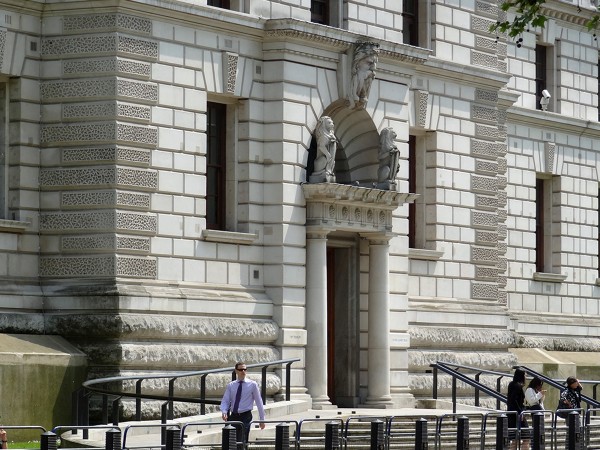 But what of fiscal policy?
But what of fiscal policy?
In its Charter for Budget Responsibility, updated in the Summer 2015 Budget, the government states its Fiscal Mandate:
3.2 In normal times, once a headline surplus has been achieved, the Treasury’s mandate for fiscal policy is:
• a target for a surplus on public-sector net borrowing in each subsequent year.
3.3 For the period outside normal times from 2015-16, the Treasury’s mandate for fiscal policy is:
• a target for a surplus on public-sector net borrowing by the end of 2019-20.
3.4 For this period until 2019-20, the Treasury’s mandate for fiscal policy is supplemented by:
• a target for public-sector net debt as a percentage of GDP to be falling in each year.
The target of a PSNB surplus by 2019-20 has been the cornerstone of recent fiscal policy. In order to stick to it, the Chancellor warned before the referendum that a slowdown in the economy as a result of a Brexit vote would force him to introduce an emergency Budget, which would involve cuts in government expenditure and increases in taxes.
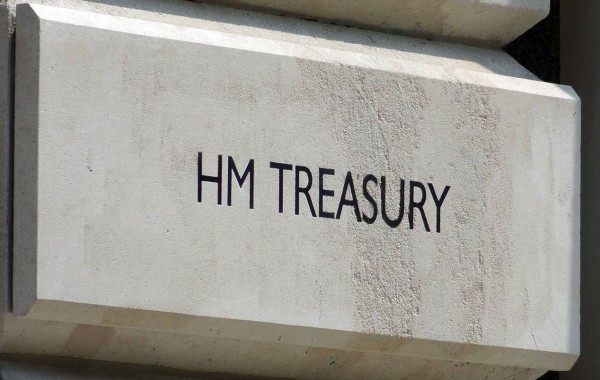 However, since the vote he is now saying that the slowdown would force him to extend the time for reaching a surplus beyond 2019-20 to avoid dampening the economy further. But does this mean he is abandoning his fiscal target and resorting to discretionary expansionary fiscal policy?
However, since the vote he is now saying that the slowdown would force him to extend the time for reaching a surplus beyond 2019-20 to avoid dampening the economy further. But does this mean he is abandoning his fiscal target and resorting to discretionary expansionary fiscal policy?
George Osborne’s answer to this question is no. He argues that extending the deadline for a surplus is consistent with paragraph 3.5 of the Charter, which reads:
3.5 These targets apply unless and until the Office for Budget Responsibility (OBR) assess, as part of their economic and fiscal forecast, that there is a significant negative shock to the UK. A significant negative shock is defined as real GDP growth of less than 1% on a rolling 4 quarter-on-4 quarter basis. If the OBR assess that a significant negative shock:
|
|
| • |
occurred in the most recent 4 quarter period; |
| • |
is occurring at the time the assessment is being made; or |
| • |
will occur during the forecast period |
then:
|
|
| • |
if the normal times surplus rule in 3.2 is in force, the target for a surplus each year is suspended (regardless of future data revisions). The Treasury must set out a plan to return to surplus. This plan must include appropriate fiscal targets, which will be assessed by the OBR. The plan, including fiscal targets, must be presented by the Chancellor of the Exchequer to Parliament at or before the first financial report after the shock. The new fiscal targets must be approved by a vote in the House of Commons. |
| • |
if the shock occurs outside normal times, the Treasury will review the appropriateness of its fiscal targets for the period until the public finances return to surplus. Any changes to the targets must be approved by a vote in the House of Commons. |
| • |
once the budget is in surplus, the target set out in 3.2 above applies. |
In other words, if the OBR forecasts that the Brexit vote will result in GDP growing by less than 1%, the Chancellor can delay reaching the surplus and thus not have to introduce tougher austerity measures. This, in effect, is what he is now saying and maintaining that, because of paragraph 3.5, it does not break the Fiscal Mandate. The nature of the next Budget, probably in the autumn, will depend on OBR forecasts.
A few days later, George Osborne announced that he plans to cut corporation tax from the current 20% to less than 15% – below the rate of 17% previously scheduled for 2019-20. His aim is not just to stimulate the economy, but to attract inward investment, as the rate would below that of any major economy and close the rate of 12.5% in Ireland. His hope would also be to halt the outflow of investment as companies seek to relocate in the EU.
Videos and podcasts
 Statement from the Governor of the Bank of England following the EU referendum result Bank of England (24/6/16)
Statement from the Governor of the Bank of England following the EU referendum result Bank of England (24/6/16)
 Uncertainty, the economy and policy – speech by Mark Carney Bank of England (30/6/16)
Uncertainty, the economy and policy – speech by Mark Carney Bank of England (30/6/16)
 Introduction to Financial Stability Report, July 2016 Bank of England (5/7/16)
Introduction to Financial Stability Report, July 2016 Bank of England (5/7/16)
 Osborne: Life will not be ‘economically rosy’ outside EU BBC News (28/6/16)
Osborne: Life will not be ‘economically rosy’ outside EU BBC News (28/6/16)
 Osborne takes ‘realistic’ view over surplus target BBC News (1/7/16)
Osborne takes ‘realistic’ view over surplus target BBC News (1/7/16)
 Why has George Osborne abandoned a key economic target? BBC News (1/7/16)
Why has George Osborne abandoned a key economic target? BBC News (1/7/16)
Articles
Mark Carney says Bank of England ready to inject £250bn into economy to keep UK afloat after EU referendum Independent, Zlata Rodionova (24/6/16)
Carney Signals Rate Cuts as Brexit Chaos Engulfs Political Class Bloomberg, Scott Hamilton (30/6/16)
Bank of England hints at UK interest rate cuts over coming months to ease Brexit woes International Business Times, Gaurav Sharma (30/6/16)
Carney prepares for ‘economic post-traumatic stress’ Financial Times, Emily Cadman (30/6/16)
Bank of England warns Brexit risks beginning to crystallise BBC News (5/7/16)
Bank of England tells banks to cut buffer to boost lending Financial Times, Caroline Binham and Chris Giles (5/7/16)
George Osborne puts corporation tax cut at heart of Brexit recovery plan Financial Times (3/7/16)
George Osborne corporation tax cut is the wrong way to start EU negotiations, former WTO boss says Independent, Hazel Sheffield (5/7/16)
George Osborne abandons 2020 UK surplus target Financial Times, Emily Cadman and Gemma Tetlow (1/7/16)
George Osborne scraps 2020 budget surplus plan The Guardian, Jill Treanor and Katie Allen (1/7/16)
Osborne abandons 2020 budget surplus target BBC News (1/7/16)
Brexit and the easing of austerity BBC News, Kamal Ahmed (1/7/16)
Osborne Follows Carney in Signaling Stimulus After Brexit Bloomberg, Simon Kennedy (1/7/16)
Questions
- Explain the measures taken by the Bank of England directly after the Brexit vote.
- What will determine whether the Bank of England engages in further quantitative easing beyond the current £385bn of asset purchases?
- How does monetary policy easing (or the expectation of it) affect the exchange rate? Explain.
- How effective is monetary policy for expanding aggregate demand? Is it more or less effective than using monetary policy to reduce aggregate demand?
- Explain what is meant by (a) capital adequacy ratios (tier 1 and tier 2); (b) countercyclical buffers. (See, for example, Economics 9th edition, page 533–7 and Figure 16.2))
- To what extent does increasing the supply of credit result in that credit being taken up by businesses and consumers?
- Distinguish between rules-based and discretionary fiscal policy. How would you describe paragraph 3.5 in the Charter for Budget Responsibility?
- Would you describe George Osborne’s proposed fiscal measures as expansionary or merely as less contractionary?
- Why is the WTO unhappy with George Osborne’s proposals about corporation tax?
- What is the Nash equilibrium of countries seeking to undercut each other’s corporation tax rates?
 In this blog we show how we can apply fiscal metrics to assess the UK government’s fiscal stance. This captures the extent to which fiscal policy contributes to the level of economic activity in the economy.
In this blog we show how we can apply fiscal metrics to assess the UK government’s fiscal stance. This captures the extent to which fiscal policy contributes to the level of economic activity in the economy. The fiscal stance is commonly estimated by measures of pubic-sector borrowing. To understand this, we can refer to the circular flow of income model. In this model, excesses of government spending (an injection) over taxation receipts (a withdrawal or leakage) represent a net injection into the circular flow and hence positively affect the level of aggregate demand for national output, all other things being equal.
The fiscal stance is commonly estimated by measures of pubic-sector borrowing. To understand this, we can refer to the circular flow of income model. In this model, excesses of government spending (an injection) over taxation receipts (a withdrawal or leakage) represent a net injection into the circular flow and hence positively affect the level of aggregate demand for national output, all other things being equal.  Chart 1 shows public-sector net borrowing and the primary balance as shares of GDP for the UK since financial year 1975/76 (click here for a PowerPoint). The data are from the latest Public Finances Databank published by the Office for Budget Responsibility, published on the day of the Autumn Budget in October (see Data links below).
Chart 1 shows public-sector net borrowing and the primary balance as shares of GDP for the UK since financial year 1975/76 (click here for a PowerPoint). The data are from the latest Public Finances Databank published by the Office for Budget Responsibility, published on the day of the Autumn Budget in October (see Data links below). Chart 2 shows both net borrowing and the primary deficit after being cyclically-adjusted (click here for a PowerPoint). This process adjusts these fiscal indicators to account for those parts of spending and taxation that are affected by the position of the economy in the business cycle. These are those parts that act as automatic stabilisers helping, as the name suggests, to stabilise the economy.
Chart 2 shows both net borrowing and the primary deficit after being cyclically-adjusted (click here for a PowerPoint). This process adjusts these fiscal indicators to account for those parts of spending and taxation that are affected by the position of the economy in the business cycle. These are those parts that act as automatic stabilisers helping, as the name suggests, to stabilise the economy. Chart 3 shows the magnitude of UK fiscal impulses since the mid-1970s (Click here for a PowerPoint file). The scale of the fiscal interventions in response to the COVID-19 pandemic, which included the COVID-19 Business Interruption Loan Scheme (CBILS) and Job Retention Scheme (‘furlough’), stand out sharply. In 2020 the CAPD to output ratio rose from 1.7 to 14.4%. This represents a positive fiscal impulse of 12.4% of GDP.
Chart 3 shows the magnitude of UK fiscal impulses since the mid-1970s (Click here for a PowerPoint file). The scale of the fiscal interventions in response to the COVID-19 pandemic, which included the COVID-19 Business Interruption Loan Scheme (CBILS) and Job Retention Scheme (‘furlough’), stand out sharply. In 2020 the CAPD to output ratio rose from 1.7 to 14.4%. This represents a positive fiscal impulse of 12.4% of GDP. Chart 4 focuses on the implied fiscal impulse for the forecast period up to 2029/30 (click here for a PowerPoint). The period is notable for a negative fiscal impulse each year. Across the period as a whole, this there is a cumulative negative fiscal impulse of 2.6% of GDP. Most of the ‘heavy-lifting’ of the fiscal consolidation occurs in the three financial years from 2025/26 during which there is a cumulative negative impulse of 2.0% of GDP.
Chart 4 focuses on the implied fiscal impulse for the forecast period up to 2029/30 (click here for a PowerPoint). The period is notable for a negative fiscal impulse each year. Across the period as a whole, this there is a cumulative negative fiscal impulse of 2.6% of GDP. Most of the ‘heavy-lifting’ of the fiscal consolidation occurs in the three financial years from 2025/26 during which there is a cumulative negative impulse of 2.0% of GDP. Chart 5 plots data since the mid-1950s (click here for a PowerPoint). It shows the size of total public-sector spending (also known as ‘total managed expenditures’), taxation receipts (sometimes referred as the ‘tax burden’) and total public-sector receipts as shares of GDP. This last one includes additional receipts, such as interest payments on financial assets and income generated by public corporations, as well as taxation receipts.
Chart 5 plots data since the mid-1950s (click here for a PowerPoint). It shows the size of total public-sector spending (also known as ‘total managed expenditures’), taxation receipts (sometimes referred as the ‘tax burden’) and total public-sector receipts as shares of GDP. This last one includes additional receipts, such as interest payments on financial assets and income generated by public corporations, as well as taxation receipts. The investment rule. The government is planning to increase investment. In order to do this in a financially sustainable way, the investment rule states that public-sector net financial liabilities (PSNFL) or net financial debt for short, is falling as a share GDP by 2029/30, until 2029/30 becomes the third year of the forecast period. PSNFL should then fall by the third year of the rolling forecast period. PSNFL is a broader measure of the sector’s balance sheet than public-sector net debt (PSND), which was targeted under the previous government and which was required to fall by the fifth year of the rolling forecast period.
The investment rule. The government is planning to increase investment. In order to do this in a financially sustainable way, the investment rule states that public-sector net financial liabilities (PSNFL) or net financial debt for short, is falling as a share GDP by 2029/30, until 2029/30 becomes the third year of the forecast period. PSNFL should then fall by the third year of the rolling forecast period. PSNFL is a broader measure of the sector’s balance sheet than public-sector net debt (PSND), which was targeted under the previous government and which was required to fall by the fifth year of the rolling forecast period.  As Chart 6 shows, public investment as a share of GDP has not exceeded 6% this century and during the 2010s averaged only 4.4% (click here for a PowerPoint). The forecast has it rising above 5% for a time, but easing to 4.8% by end of the period.
As Chart 6 shows, public investment as a share of GDP has not exceeded 6% this century and during the 2010s averaged only 4.4% (click here for a PowerPoint). The forecast has it rising above 5% for a time, but easing to 4.8% by end of the period. The following blog is inspired by my teaching of macroeconomic issues to my final year students at Aston University. In the classes we’ve been discussing important aspects of monetary and fiscal policy design. What has become clear to me and my students is that the trade-offs which characterise the discipline of economics are certainly alive and well in the current environment in which monetary and fiscal policy choices are being made.
The following blog is inspired by my teaching of macroeconomic issues to my final year students at Aston University. In the classes we’ve been discussing important aspects of monetary and fiscal policy design. What has become clear to me and my students is that the trade-offs which characterise the discipline of economics are certainly alive and well in the current environment in which monetary and fiscal policy choices are being made. The model explores how systemically high inflation can become established in economies when policymakers have the political incentive to lower unemployment or increase output above its long-run equilibrium value. This may be the case if governments operate monetary policy rather than the central bank (of if the central bank operates monetary policy but follows government objectives). By adopting expansionary monetary policy, governments can increase their popularity.
The model explores how systemically high inflation can become established in economies when policymakers have the political incentive to lower unemployment or increase output above its long-run equilibrium value. This may be the case if governments operate monetary policy rather than the central bank (of if the central bank operates monetary policy but follows government objectives). By adopting expansionary monetary policy, governments can increase their popularity. Yet central bank independence is not without its own issues and this has been an important part of the discussions with my students. Today, many economies are continuing to experience the effects of the inflationary shocks that began in 2021 (see Chart 1 for the UK CPI inflation rate: click
Yet central bank independence is not without its own issues and this has been an important part of the discussions with my students. Today, many economies are continuing to experience the effects of the inflationary shocks that began in 2021 (see Chart 1 for the UK CPI inflation rate: click  The second topic area that I have been discussing in my final-year macroeconomics classes has centred around fiscal policy and the state of the public finances. The context for this is that we have seen a significant increase in public debt-to-GDP ratios over the past couple of decades as the public sector has attempted to absorb significant economic shocks. These include the global financial crisis of 2007–8, the COVID-19 pandemic and the cost-of-living crisis. These interventions in the case of the UK have seen its public debt-to-GDP ratio more than triple since the early 2000s to close to 100% (see Chart 2: click
The second topic area that I have been discussing in my final-year macroeconomics classes has centred around fiscal policy and the state of the public finances. The context for this is that we have seen a significant increase in public debt-to-GDP ratios over the past couple of decades as the public sector has attempted to absorb significant economic shocks. These include the global financial crisis of 2007–8, the COVID-19 pandemic and the cost-of-living crisis. These interventions in the case of the UK have seen its public debt-to-GDP ratio more than triple since the early 2000s to close to 100% (see Chart 2: click  This fiscal arithmetic is important in determining a government’s fiscal choices. It shows the implications for spending and taxation. These implications become ever more important and impactful on people, businesses, and society when the fiscal arithmetic becomes less favourable. This is a situation that appears to be increasingly the case for many countries, including the UK, as the rate of interest on public debt rises relative to a country’s rate of economic growth. As this happens, governments are increasingly required to run healthier primary balances. This of course implies a tightening of their fiscal stance.
This fiscal arithmetic is important in determining a government’s fiscal choices. It shows the implications for spending and taxation. These implications become ever more important and impactful on people, businesses, and society when the fiscal arithmetic becomes less favourable. This is a situation that appears to be increasingly the case for many countries, including the UK, as the rate of interest on public debt rises relative to a country’s rate of economic growth. As this happens, governments are increasingly required to run healthier primary balances. This of course implies a tightening of their fiscal stance. With many countries experiencing low growth some 12 years after the financial crisis and with new worries about the effects of the
With many countries experiencing low growth some 12 years after the financial crisis and with new worries about the effects of the  Sajid Javid resigned at the time of the recent Cabinet reshuffle, citing the reason that he would have been required to sack all his advisors and use the advisors from the Prime Minister’s office. His successor, the former Chief Secretary to the Treasury, Rishi Sunak, is expected to adopt a looser fiscal rule in his Budget on March 11. This would result in bigger infrastructure spending and possibly some significant tax cuts, such as a large increase in the threshold for the 40% income tax rate.
Sajid Javid resigned at the time of the recent Cabinet reshuffle, citing the reason that he would have been required to sack all his advisors and use the advisors from the Prime Minister’s office. His successor, the former Chief Secretary to the Treasury, Rishi Sunak, is expected to adopt a looser fiscal rule in his Budget on March 11. This would result in bigger infrastructure spending and possibly some significant tax cuts, such as a large increase in the threshold for the 40% income tax rate. Whether a fiscal stimulus can increase long-term growth depends on whether it can increase capacity. The government hopes that infrastructure expenditure will do just that. However, there is a long time lag between committing the expenditure and the extra capacity coming on stream. For example,
Whether a fiscal stimulus can increase long-term growth depends on whether it can increase capacity. The government hopes that infrastructure expenditure will do just that. However, there is a long time lag between committing the expenditure and the extra capacity coming on stream. For example,  The Institute of Fiscal Studies (IFS) has just published its annual ‘
The Institute of Fiscal Studies (IFS) has just published its annual ‘ But can fiscal policy be used over the longer term to offset the downward shock of Brexit, and especially a no-deal Brexit? The problem is that, if the government wishes to prevent government borrowing from soaring, it would then have to start reining in public spending again. Another period of austerity would be likely.
But can fiscal policy be used over the longer term to offset the downward shock of Brexit, and especially a no-deal Brexit? The problem is that, if the government wishes to prevent government borrowing from soaring, it would then have to start reining in public spending again. Another period of austerity would be likely.


